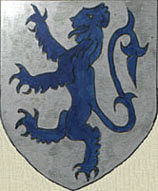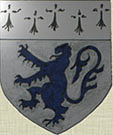John Andrew, The Skelton Smuggler.
|
 Ship Inn.
Ship Inn.
|
LANDLORD OF THE SHIP INN.
John Andrew married Anne Harrison at All Saints Church, Skelton in 1780.
He was buried in the South corner of the same Church yard in 1844.
In the intervening years he gained local fame as the Master of the Cleveland Hunt and Officer in the Cleveland Volunteers
But he is remembered chiefly for his notoriety as the 'King of the Smugglers'.
He was a Scot, having been born in 1757 at Inverberbie, Kincardine.
In 1778 he attained the degree of Master Mason of Kilwinnie Lodge, Montrose, [source - North Britain No. 18.]
He must have arrived in Skelton shortly afterwards to become Landlord of the Ship Inn, Old Saltburn.
At this time the modern town of Saltburn did not exist. All the land on the Ship Inn side of Skelton Beck was in Skelton Parish and belonged to the Skelton Castle Estate.
In fact it was not until 1934 that it was transferred from the control of Skelton and Brotton Urban District Council to Saltburn Council.
SMUGGLING PAID.
In the late 18th Century smuggling was a very profitable occupation and
|
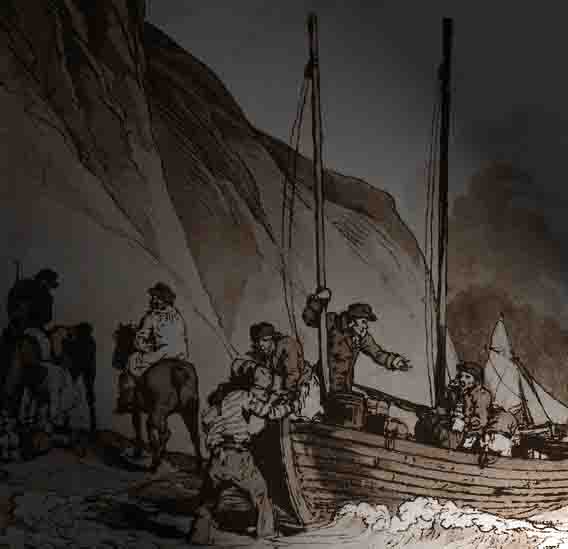
|
was carried on by communities all round Britain.
In order to raise money necessary to pay for fighting the frequent Continental Wars the Government had raised import duties on Spirits, tea, coffee, tobacco, lace, silk etc to unprecedented levels.
The Customs and Excise tax on a gallon of brandy was over 5 shillings, which was the equivalent of a week's wages.
The duties on importing tea reached 119% in the 1750s and in 1784 the Prime Minister, William Pitt the Younger, suggested that of the 13 million pounds in weight of tea consumed in Britain, only 5.5 million had been brought in legally.
To achieve such quantities smuggling was not done by the odd hidden chest or cask, but by the ship-load.
One trip could bring in thousands of gallons of spirits, enormous amounts to keep hidden and enormous profits when sold.
The penalty, if caught, could be hanging, but that was the sentence for many crimes in those days and whole gangs took the chance.
The gentry no doubt financed much of the smuggling activities, while keeping their own hands clean. For those who bought the goods it was better not to pry.
If you wake at midnight, and hear a horse's feet,
Don't go drawing back the blind, or looking in the street;
Them that ask no questions isn't told a lie.
Watch the wall, my darling, while the Gentlemen go by!
Five and twenty ponies,
Trotting through the dark.
Brandy for the Parson,
Baccy for the Clerk;
Laces for a lady, letters for a spy,
And watch the wall, my darling,
While the Gentlemen go by!
Rudyard Kipling.
|
The British coast was divided into 33 areas with preventative officers to combat the smugglers, but it was impossible to cover all the countless coves and beaches and even when caught it was hard to get witnesses to testify because they had already been threatened with the consequences of ratting.
At sea the British Navy had patrol ships on the look-out for smuggling, but at that time most ships were chiefly occupied with fighting our Continental enemies.
'The Newcastle Chronicle' of June 20th 1778 carried this warning:-
"We are advised from Coatham, Redcar and other places on the Yorkshire coast, that the Smugglers there land in a most flagrant manner.
It is the practise for fifteen or twenty to come on shore armed with muskets, blunder busses etc, threatening death and destruction to anyone who dares offer to oppose them."
A letter of 1775 from three Customs Officers working in the Markse area House describes the severe injuries they sustained from an altercation with a group of smugglers.
Accompanying the letter is a surgeon's bill and a request that the cost be met by Customs Office.
"We attempted to prevent the said Goods being Run and having 'siesed' part thereof, the Crew belonging to the said Boat, consisting of seven unknown persons, rescued what we had seized and with handspikes and Bludgeons desperate Beat and Maimed us."
Newcastle Courant, Saturday 5 August 1780:-
On the 20th past a smuggling Lugger, under Dutch colours, carrying two six pounders, six four-pounders, a number of swivels, and 30 stout men, each armed with a long pistol and a cutlass, was taken by two of his Majesty’s cutters, as she was riding at anchor near 'Marsk' and Saltburn, in Cleveland.
When the cutters appeared, the Lugger sent off a coble with 80 tubs of gin, (the remainder of 1000) each tub containing from 17 to 20 quarts, towards Marsk, which being observed by the headmost cutter.
She sent out her long boat, well manned, to seize it, which they did.
During the 'chace' the Smuggler fired two pieces of cannon at the long boat, without effect.
On seeing the other cutter coming up, all the smugglers, except two men and a boy, escaped in their long boats to Saltburn.
Had not the smuggler fired on the cutter’s men, she could not have been seized, as no uncustomed goods were found on board.
|
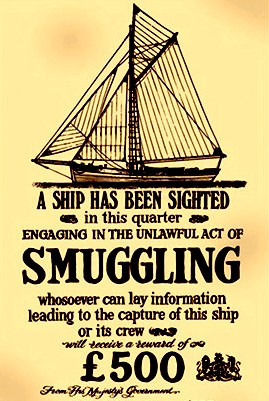
|
1763 SMUGGLERS GROUNDED.
An article of this year says "a 30 ton sloop went aground at Saltburn after the crew had gone ashore and left a boy on board the anchored vessel.
It was carrying contraband including over one thousand gallons of brandy and three hundred gallons of gin.
Two men from Skelton, Tommy Tiplady and Bill Richardson, were to help unload it."
THE ANDREW'S GANG.
John Andrew went into partnership in the smuggling trade with Thomas King, a Brewer, of Kirkleatham.
King later married one of John Andrew's daughters, Elizabeth.
Together they bought a lugger named the "Morgan Rattler", gathered a like-minded crew and prospered.
When word went round that "John Andrew's cow has calved" clients knew that another cargo had been landed.
Ship loads would be bought cheaply in places like Holland and brought to Britain where their activities were not confined to Saltburn, but ranged to different places along the north east coast.
It is reputed at one time John Andrew and his gang were surprised by the Excise men in the Blackhall Rocks area.
John made his escape on horseback and rode to Tees-mouth, which unlike today was a broad estuary.
There he roused a fisherman and offered him a guinea to be taken across the river.
Landing on the Majuba sands, he approached a Coastguard man and asked the time, then made his way home.
Later he was arrested and appeared before a Court on a charge of smuggling.
He called the Coastguard as a witness and it was decided he could not have been at the scene at the time and also South of the river a short time later.
The only crossing over the Tees at this time was at Yarm, so a ride of a considerable distance.
JOINS THE LANDED GENTRY.
Many a mansion was built out of smuggling profits.
John Andrew used his smuggling gains to join the landed gentry by buying the White House Farm at Saltburn.
From Sir Alfred Pease's 'Memories of Saltburn' :-
"Saltburn was then but a fishing hamlet and colony of Smugglers on the seashore.
Not the large and fashionable watering place it has since developed into.
|
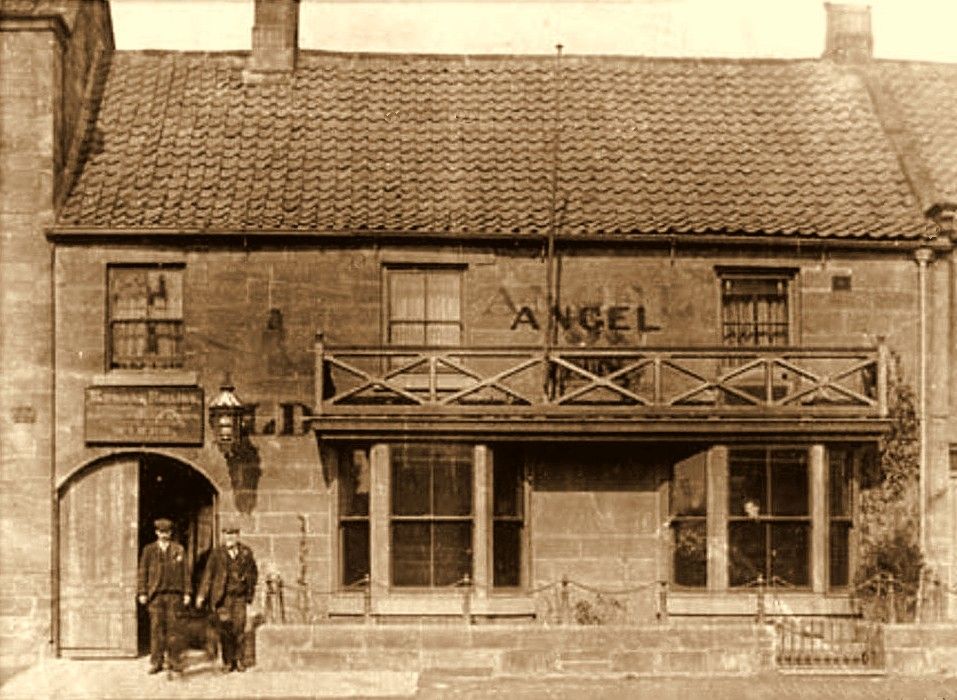
The 'Angel' Inn, Loftus, where the Cleveland Hunt was started.
Photograph taken a century of so later.
|
On the top of the cliffs, with a wooded ravine running inland, stood then and still stands the home of the Andrew family, a farmhouse known as the White House.
Up this secluded ravine many a string of pack horses wended their way with the contraband goods, which found a ready market at Guisborough, Stokesley and in the country-side.
This illicit trade being encouraged both by the gentry and clergy as well as by the farmers......
Many a cargo was run ashore at Saltburn and stored in the White House, and in the clay holes of Hob Hill, in the ravine beyond the house.
You may now see in the last stall of the stables a large flagstone, which when removed, discloses the entrance to a spacious cellar.
In this stall John Andrew had always a celebrated mare who would kick like mad when any but her master approached that stall.
Upstairs in the house is a room which had a secret hiding place, where in case of a search the men might hide or lie in ambuscade."
AN OFFICER IN THE VOLUNTEERS.
To add to his seeming respectability John Andrew served in the local Volunteers.
On the 24th October, 1804, he was commissioned in the Cleveland Volunteer Infantry.
In 1807 he was made Lieutenant.
|

The Cleveland Hunt.
Roseberry Topping in background.
|
In 1808 he was made Lt in the 3rd Regiment of Local Militia.
On the 16th May, 1809 he was promoted Captain in the same regiment.
The order each time was signed by the Duke of Leeds.
FIRST MASTER OF THE CLEVELAND HUNT.
From the "The Cleveland Hunt" by A E Pease.
On the 5th June 1817, at a meeting in the Angel Inn, Loftus John Andrew was elected as the first Master of the newly formed 'Roxby and Cleveland Hounds'.
From 'The Cleveland Hounds', by A E Pease:-
At the Angel Inn at Loftus, on a summer's afternoon, we may picture John Andrew Snr, Isaac Scarth, Henry Clarke, Henry Vansittart Esq, Thomas Chaloner Esq and the other signatories to the
rules then drawn up, sitting with their tumblers of punch, making a treaty.
The Hounds were taken to Saltburn, then but a fishing hamlet on the sea-shore, where, for more than fifty years, the management was in the hands of the Andrew family.
They hunted foxes in the winter and, with a few of the old Hounds, otters in the summer.
A few years after this the Roxby was dropped from the name of the pack, and they became the 'Cleveland'.
|
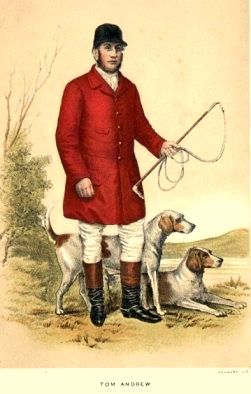
|
FOXHUNTING AND SMUGGLING CONTINUED BY THE ANDREW'S FAMILY.
John Andrew hunted them until his death in 1835, assisted by his son, John Andrew Jun, who took them when his father gave them up.
John Jun was Master until 1855, when they were taken by his son, Tom, who had them until 1870, having, previous to becoming Master, acted as huntsman to his father.
Tom, altogether, hunted the Hounds for thirty-three years, having many grand runs, and sometimes hunting when the snow was deep on the ground."
CAUGHT BY THE EXCISE MEN.
It has long been believed that, after a lifetime of dodging the Excise men, John Andrew, Senior, was eventually caught in 1827 at Hornsea while off-loading an illicit cargo.
Alan Ward of Saltburn is a direct descendant of Andrew and having done much research into his ancestor, has kindly contributed many of the details described here.
Alan points out that John would have been 70 by this time and it was, in fact, his son, also called John [1794 to 1855] who was caught in this act of Smuggling.
Three items, found by Alan, confirm this.
The first is a letter from the Customs House, London, dated 20 Jan 1825, asking the Customs Collector to enquire into the ability of two men to meet the bail amount of £95 for John Andrew.
The second is a letter asking the Collector to take the necessary measures for the release of John Andrew, "Junior" from York Castle.
Alan obtained this information from a report in the Cleveland Family History journal by a John Warwick Andrew, b 1925, of Oxford, who did the original research.
|
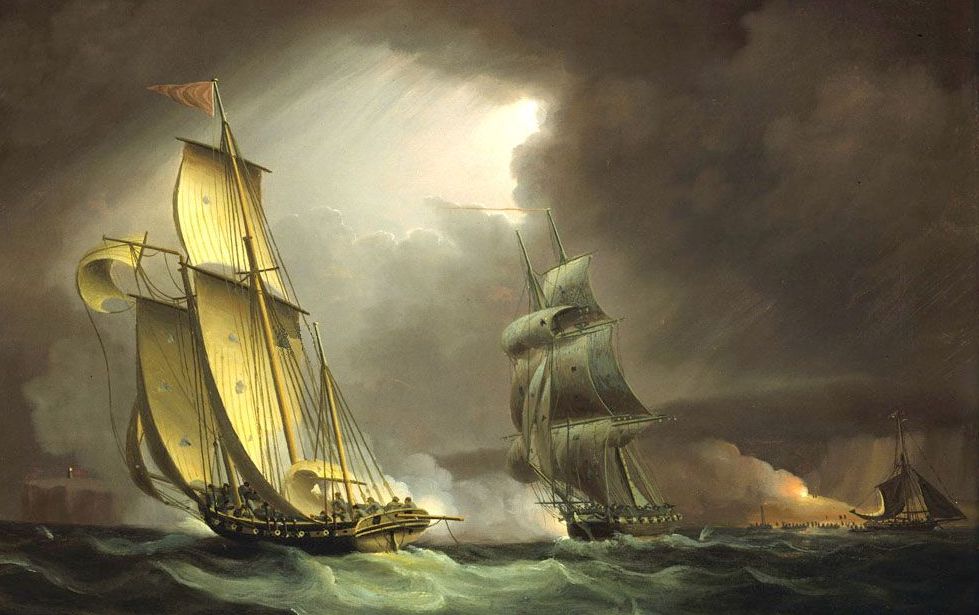
A smuggling Lugger, chased by a Royal Navy Brig.
Painting by Thomas Buttersworth, 1768 to 1842.
|

John Andrew, Senior's Headstone in the South corner of Skelton All Saints Churchyard.
|
The third is an article in the Northern Echo, dated 28 Nov 1935, dealing with Sir Alfred Pease's 'Memories of Saltburn':-
John Andrew, Junior, had the bad luck to be caught running a cargo ashore at Hornsea and was fined an enormous sum of £100.000, I believe about 1827, and, of course, unable to pay a fraction of the fine, was imprisoned in York castle.
After two years of durance there, Henry Vansittart, of Kirkleatham, who had carried on the hounds during John's absence, was able to secure his release through the influence of his relative Lord Bexley, who was in the Goverment.
In those days the discipline for debt was not strict, and Tom Parrington told me that John Andrew carried on his smuggling by correspondence through agents all the time he was a prisoner.
From his release until his father died in 1835, he seemed to have been reduced to poverty, for he lived in a small cottage at Boosbeck and only had a grey pony, 15 h.h. on which he hunted hounds twice a week.
The pony was "as hard as iron" but had a temper and would always run away with his Master and was not particular as to the direction in which he bolted.
It was not uncommon to see the gallant grey tearing across country in quite another direction to that which the hounds were running.
The pony never got a summer rest for then his owner yoked him to a cart and he carted stones, seaweed, or anything else at a job which earned John a few shillings.
After his father's death, Andrews was Master of the hounds, and his circumstances improved a little as the hunt paid him a small salary.
John Andrew, Junior, died in 1855 and was also buried in Skelton Church yard.
|
He left six children, Thomas Pressick, Ann, James, George and Mary.
His eldest son Tom, pictured above, took his place as Master of the Cleveland Hunt and remained so until 1870.
END OF THE SMUGGLING AGE.
The Napoleonic Wars ended in 1815 and import duties were reduced making smuggling gradually less profitable.
Also it became a more dangerous trade with a greater risk of capture, as Royal Navy vessels were freed to patrol the seas around Britain and 7000 sailors were redeployed, when the Coast Guard service was started in 1820.
A row of Coastguard cottages were fittingly built on the cliff top above the old Ship Inn.
THE ANDREW FAMILY'S FORTUNES PROSPER THEN DECLINE.
The Andrew family at the White House continued to prosper under John Andrew, junior's sons, Tom and George, into the late 19th Century.
In 1886 their finances allowed them to make a large loan to John Thomas Wharton of Skelton Castle.
The family fortune seems to have been dissipated by being shared out between George's 11 children and ended in the suicide of one of them in Ruby St, Saltburn.
That story can be read here.
|
